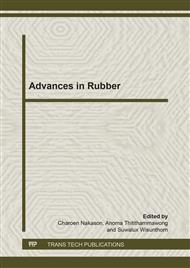p.365
p.369
p.373
p.377
p.381
p.385
p.391
p.395
p.399
Preparation of New Polyols Based on Cis-1,4-Polyisoprene by Using 1,3-Dipolar Cycloaddition
Abstract:
This research focuses on synthesis and modification of polyol precursors derived from cis-1,4-polyisoprene (PI). These new polyol precursors can be converted to high value-added polyurethane (PU). The epoxidized hydroxytelechelic PI (EHTPI) prepared by chemical modification from PI was used as starting material for polyol synthesis. 1,3-Dipolar cycloaddition between a terminal alkyne and an azide has rapidly become the most popular click reaction. We applied this reaction to couple azide-functionalized PI and alkyne-functionalized sugar for preparing polyols. For azide functionalization, 1-methyl epoxidized cyclohexane was used as a model molecule, and various conditions for epoxide ring opening of 1-methyl epoxidized cyclohexane and EHTPI were investigated. The cycloaddition of alkyne and azide was carried out in the presence of sodium ascorbate and copper sulfate. The polyol precursors obtained might be used to prepare biodegradable polyol PU.
Info:
Periodical:
Pages:
381-384
Citation:
Online since:
November 2013
Price:
Сopyright:
© 2014 Trans Tech Publications Ltd. All Rights Reserved
Share:
Citation:


